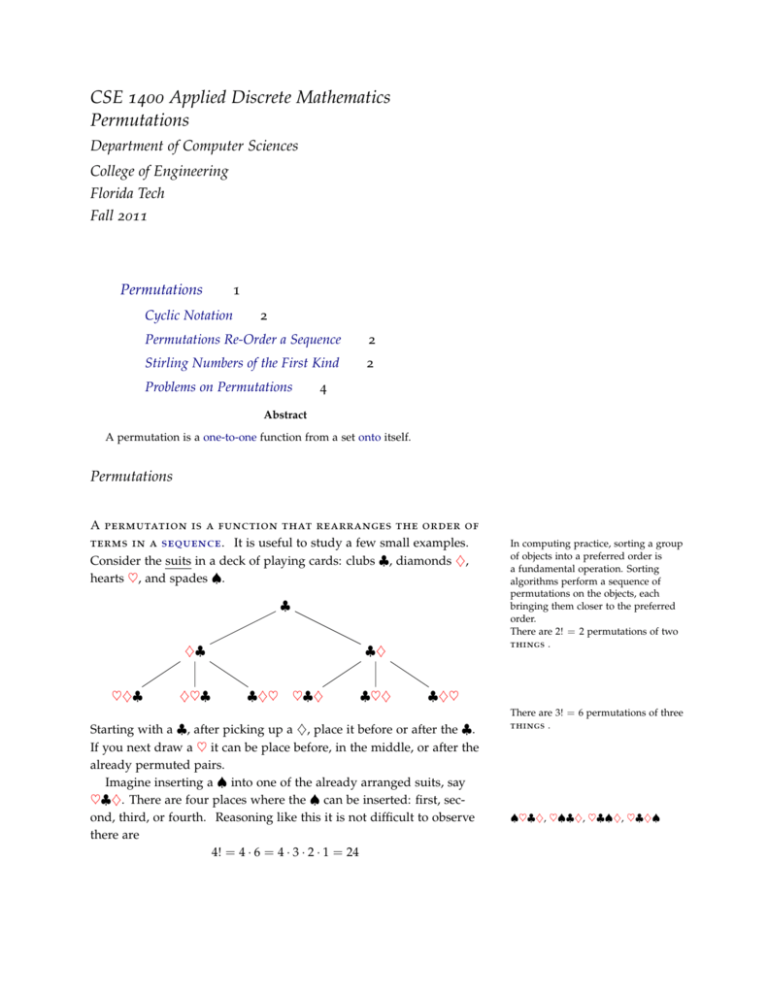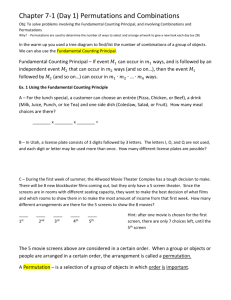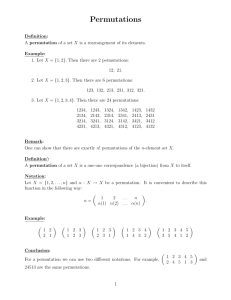Permutations - Florida Tech Department of Computer Sciences
advertisement

CSE 1400 Applied Discrete Mathematics
Permutations
Department of Computer Sciences
College of Engineering
Florida Tech
Fall 2011
Permutations
1
Cyclic Notation
2
Permutations Re-Order a Sequence
2
Stirling Numbers of the First Kind
2
Problems on Permutations
4
Abstract
A permutation is a one-to-one function from a set onto itself.
Permutations
A permutation is a function that rearranges the order of
terms in a sequence. It is useful to study a few small examples.
Consider the suits in a deck of playing cards: clubs ♣, diamonds ♦,
hearts ♥, and spades ♠.
♣
♦♣
♥♦♣
♦♥♣
♣♦
♣♦♥
♥♣♦
♣♥♦
In computing practice, sorting a group
of objects into a preferred order is
a fundamental operation. Sorting
algorithms perform a sequence of
permutations on the objects, each
bringing them closer to the preferred
order.
There are 2! = 2 permutations of two
things .
♣♦♥
Starting with a ♣, after picking up a ♦, place it before or after the ♣.
If you next draw a ♥ it can be place before, in the middle, or after the
already permuted pairs.
Imagine inserting a ♠ into one of the already arranged suits, say
♥♣♦. There are four places where the ♠ can be inserted: first, second, third, or fourth. Reasoning like this it is not difficult to observe
there are
4! = 4 · 6 = 4 · 3 · 2 · 1 = 24
There are 3! = 6 permutations of three
things .
♠♥♣♦, ♥♠♣♦, ♥♣♠♦, ♥♣♦♠
cse 1400 applied discrete mathematics
permutations 2
permutations on 4 things .
Let A be a ith n elements. The symbol for the count of ways to
permute the elements of A is n! and pronounced “n factorial.” This
count of permutations can be computed by evaluating the product
n! = n(n − 1)(n − 2) · · · (2)(1)
called n factorial.
Cyclic Notation
Under a permutation a thing in spot n “goes to” spot m.
Cyclic notation describes “goes to.”
Consider the permutation “shift by 2”
[0, 2, 4, · · · , 24][1, 3, 5, · · · , 25]
on the English alphabet applied to the characters in the statement
a man a plan a canal panama
c ocp c rncp c ecpcn rcpcoc
In computing practice, you may need
to save the thing is spot m before
overwriting it with the thing from
spot n.
For instance, under the permutation
Original Order
Permuted Order
0
4
1
3
2
2
3
1
4
0
value 0 goes to position 4 and 4 goes to
0, 1 goes to position 3 and 3 goes to 1,
and 2 stays put. In cyclic notation, the
above permutation is written
[0, 4][1, 3][2]
Permutations Re-Order a Sequence
For small sets each permutation can be listed. Let A be a
set with cardinality |A| = n. There are n factorial different permutations of the elements in A. Figure 1 shows the 3! = 6 permutations
of the elements in {0, 1, 2} written in cyclic notation.
The permutations on {0, 1, 2, 3} can be defined recursively, that is,
from the permutations on {0, 1, 2}. For instance, to build all 2-cycle
permutations of {0, 1, 2, 3}. use the one and two-cycle permutations
of {0, 1, 2}.
1. Append the cycle [3] to each 1-cycle permutation of {0, 1, 2}
2. Insert new element 3 in three positions in each 2-cycle permutations of {0, 1, 2}
n
Using [m
] to name the count of 2-cycle permutations of a 4-element
set, write
4
3
3
=
+2
= 2 + 3 · 3 = 11
2
1
2
These eleven permutations are shown in figure 2.
Okay! Blank did not shift.
It is convenient to say there is a permutation of the ∅, so there is 1. That is,
0! = 1.
cse 1400 applied discrete mathematics
permutations 3
Figure 1: Cyclic notation for the 3!
permutations of {0, 1, 2}.
Permutations
[0, 1, 2]
[0][1, 2]
[0, 2, 1]
[1][0, 2]
[0][1][2]
[2][0, 1]
Figure 2: Cyclic notation for the 4!
permutations of {0, 1, 2, 3}.
Permutations
[0, 1, 2, 3]
[0, 1, 2][3]
[0][1, 2][3]
[0, 1, 3, 2]
[0, 2, 1][3]
[1][0, 2][3]
[0, 3, 1, 2]
[0][1, 2, 3]
[2][0, 1][3]
[0, 2, 1, 3]
[0][1, 3, 2]
[0][1][2, 3]
[0, 2, 3, 1]
[0, 3][1, 2]
[0][1, 3][2]
[0, 3, 2, 1]
[1][0, 2, 3]
[0, 3][1][2]
[1][0, 3, 2]
[1, 3][0, 2]
[2][0, 1, 3]
[2][0, 3, 1]
[2, 3][0, 1]
[0][1][2][3]
cse 1400 applied discrete mathematics
permutations 4
Stirling Numbers of the First Kind
The elements of set with cardinality n can be permuted
n
into m cycles in [ m
] ways. Stirling numbers of the first kind are
defined by the recurrence equation
n
n−1
n−1
=
+ ( n − 1)
m
m−1
m
with boundary conditions
n
= 1,
n
and
n
= 0, for n > 0
0
Check that the following arithmetic can
be verified by the numbers in table 1.
4
3
3
=
+3
= 3+3·1
3
2
3
5
4
4
=
+4
= 11 + 4 · 6
3
2
3
7
6
6
=
+6
= 85 + 6 · 15
5
4
5
n
The notation [m
] is called n cycle m.
Table 1: Stirling numbers of the first
n
kind [m
] count the permutations with m
cycles of n things .
0
n
0
1
2
3
4
5
6
7
8
1
0
0
0
0
0
0
0
0
n
Stirling Numbers of the First Kind [m
]
Cycle m
1
2
3
4
5
6
0
1
1
2
6
24
120
720
5040
0
0
1
3
11
50
274
1764
13068
0
0
0
1
6
35
225
1624
13132
0
0
0
0
1
10
85
735
6769
0
0
0
0
0
1
15
175
1960
0
0
0
0
0
0
1
21
322
7
8
0 0
0 0
0 0
0 0
0 0
0 0
0 0
1 0
28 1
Problems on Permutations
1. True or false: A permutation of X is a one-to-one function from X onto X.
2. True or false: [c, a, b] is a permutation of { a, b, c}.
3. True or false: [ a, a, b] is a permutation of { a, b, c}.
4. True or false: There are 2n permutations of an n element set.
5. True or false: There are n! permutations of an n element set.
6. Let H = {0, 1, 2, . . . , E, F }.
(a) How many permutations can be defined on H?
(b) In how many ways can you choose 5 elements from H
cse 1400 applied discrete mathematics
permutations 5
(c) In how many ways can you choose and permute 5 elements from H
(d) How many permutations on H have 16 cycles?
(e) How many permutations on H have 1 cycle?
7. Let X be an 8-element set. How many permutations on X have 4 cycles? That is, what is the value of
the Stirling number [84] “8 cycle 4”? You may want to know row 7 of Stirling’s triangle of the first kind is
7
0
0
1
2
3
4
720 1764 1624 735
···
···
8. Use cyclic notation to describe the permutation (0, 1, 2, 3) of the elements in the set {0, 1, 2, 3}
9. Use cyclic notation to describe the permutation (0, 2, 4, 6, 1, 3, 5, 7) of the octal alphabet {0, 1, 2, 3, 4, 5, 6, 7}
10. Use cyclic notation to describe the permutation (1, 2, 0, 7, 3, 4, 5, 6) of the octal alphabet {0, 1, 2, 3, 4, 5, 6, 7}









